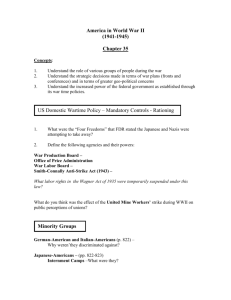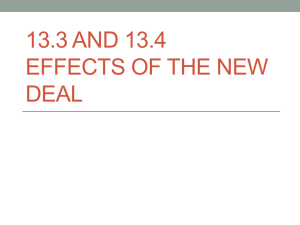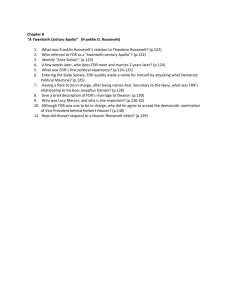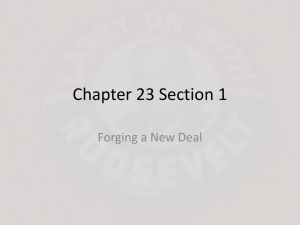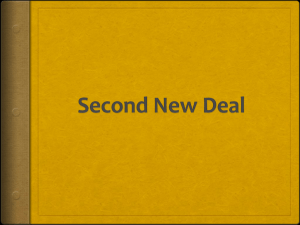The New Deal
advertisement
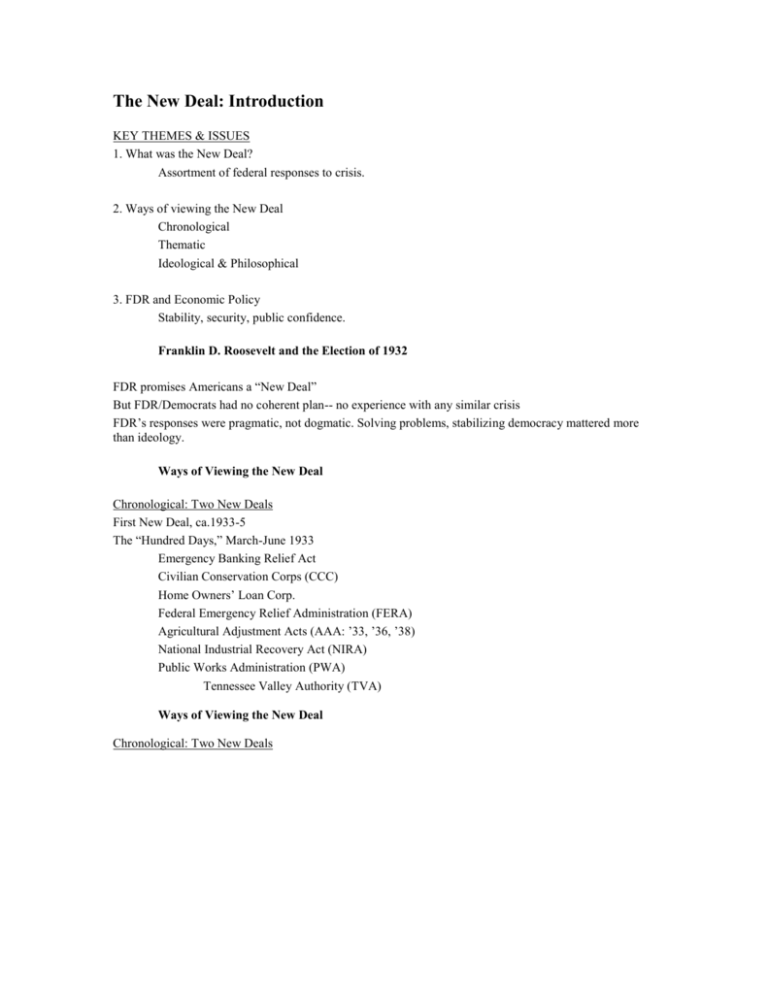
The New Deal: Introduction KEY THEMES & ISSUES 1. What was the New Deal? Assortment of federal responses to crisis. 2. Ways of viewing the New Deal Chronological Thematic Ideological & Philosophical 3. FDR and Economic Policy Stability, security, public confidence. Franklin D. Roosevelt and the Election of 1932 FDR promises Americans a “New Deal” But FDR/Democrats had no coherent plan-- no experience with any similar crisis FDR’s responses were pragmatic, not dogmatic. Solving problems, stabilizing democracy mattered more than ideology. Ways of Viewing the New Deal Chronological: Two New Deals First New Deal, ca.1933-5 The “Hundred Days,” March-June 1933 Emergency Banking Relief Act Civilian Conservation Corps (CCC) Home Owners’ Loan Corp. Federal Emergency Relief Administration (FERA) Agricultural Adjustment Acts (AAA: ’33, ’36, ’38) National Industrial Recovery Act (NIRA) Public Works Administration (PWA) Tennessee Valley Authority (TVA) Ways of Viewing the New Deal Chronological: Two New Deals Second New Deal, ca.1935-8 Federal Housing Administration Social Security Act National Labor Relations Act (a/k/a the “Wagner Act”) Fair Labor Standards Act Works Progress Administration Ways of Viewing the New Deal Thematic: Relief measures (Most in “First” New Deal) Recovery measures (Some in “First”, Some in “Second” New Deal) Reform measures (Most in “Second” New Deal) Such neat distinctions often blurred, for example, by major public works projects. Were they about jobs, or about economic stimulus, or about improving society? Ways of Viewing the New Deal Ideological/Philosophical Goal was consistent: to preserve capitalism and the free market (not to replace them). New Deal related to progressivism, but embraced the modern corporate, industrial, consumer economy. Wanted a stable political and economic system that would foster “the American Dream.” FDR offered bold govt. action instead of inaction, but not necessarily consistent economic & social policies Inspired confidence, connected with people: “fireside chats” Sought new institutions to enhance confidence: Federally-insured bank accounts, Social Security, guaranteed home loans. Expanded executive power & federal interventionism to new peacetime levels. Pragmatic, not dogmatic. Experimental, not systematic. (E.g.: national “bank holiday,” deficit spending, “alphabet soup” agencies). Some say FDR and the New Deal innovations went too far, others say, not far enough. FDR and Economic Policy Keynesian Economics (named for British economist John Maynard Keynes) “Priming the Pump” with Govt. spending to stimulate employment and consumption Critics assailed deficits, warned of bankrupt government. FDR a reluctant Keynesian, also wanted a balanced budget. Finally “converted” after 1937-8 budget crisis and the “Roosevelt recession.” War-related federal spending finally ended the Great Depression, seeming to prove the value of Keynesian economic practice. Thoughts to hold onto: 1. 2. 2. FDR’s bold, flexible approach to two of the nation’s most crucial passages (Depression and WW II) means his presidency defined the era. Did not try to weaken the free market, but rather to preserve it when it seemed to be faltering. Built upon progressive reform traditions, carried them further than ever, settling the question of a federal role in economic regulation. 3. 4. 5. Increased the power of the office of the presidency. Established a philosophy of government that defines the American political economy—free markets, regulated and stabilized by federal agencies. The Second World War, not the New Deal, ultimately ended the Depression.




